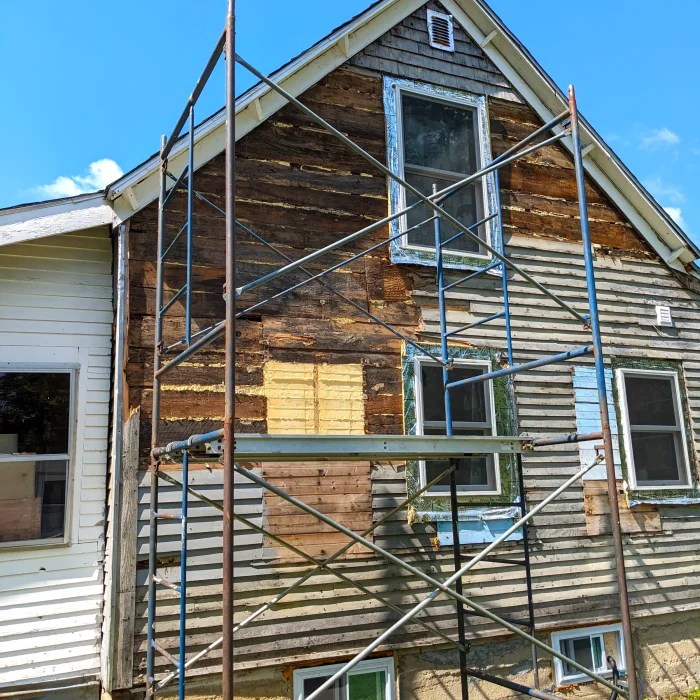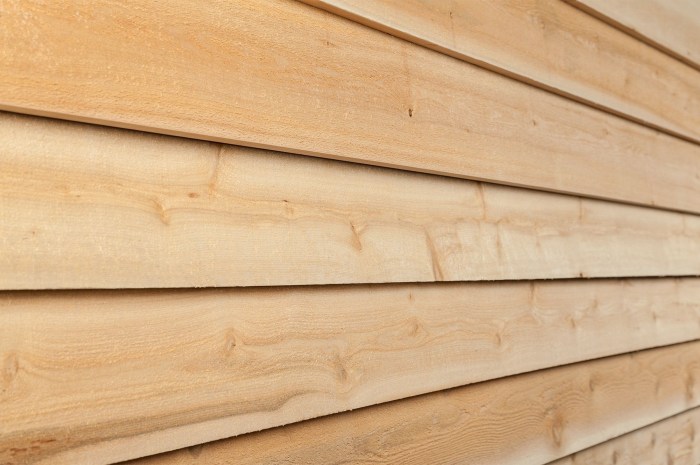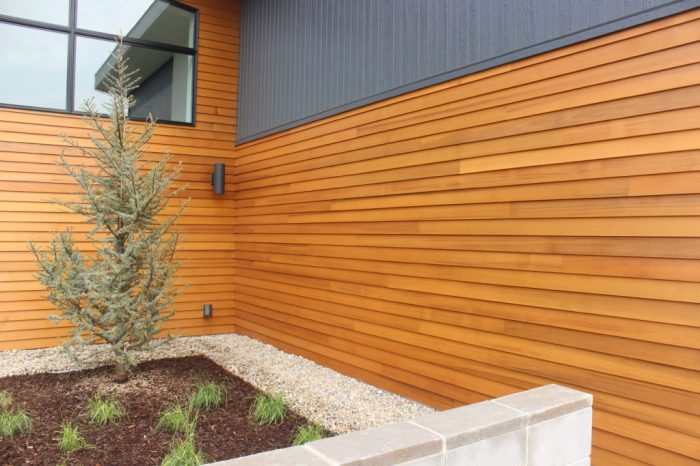Clear cedar siding: The very name evokes images of rustic charm and enduring elegance. This natural wood siding option offers a unique aesthetic appeal, setting it apart from other materials like painted cedar, vinyl, or fiber cement. Its warm tones and distinctive grain patterns can dramatically enhance any home’s exterior, from cozy cottages to grand Victorian estates. But beyond its beauty, clear cedar siding boasts impressive durability and longevity when properly maintained, making it a worthwhile investment for homeowners seeking both style and substance.
This guide delves into every aspect of clear cedar siding, from its visual impact and maintenance requirements to its cost, installation process, and environmental footprint. We’ll explore the various installation methods, address common problems, and compare it to alternative siding options to help you make an informed decision about whether clear cedar siding is the right choice for your home.
Clear Cedar Siding

Clear cedar siding offers a timeless appeal, bringing a touch of natural elegance to any home. Its versatility allows it to complement a wide range of architectural styles, from rustic cabins to modern farmhouses, creating a unique and visually striking exterior. The natural variations in grain and color contribute to its distinctive character, making each installation unique.
Clear Cedar Siding Aesthetics and Design
The visual appeal of clear cedar siding stems from its inherent beauty. The rich, warm tones of the wood, ranging from light golden hues to deeper browns, create a sense of natural warmth and sophistication. This natural variation in color adds depth and texture, unlike the uniformity often found in other siding materials. The straight grain of clear cedar contributes to a clean, sophisticated look, while the subtle knots and variations in color add visual interest.
Clear Cedar Siding Compared to Other Materials
Clear cedar siding offers a distinct aesthetic compared to other options. Painted cedar siding, while still utilizing the natural wood, presents a more uniform and controlled appearance through the application of color. Vinyl siding, in contrast, provides a smooth, low-maintenance surface but lacks the natural texture and warmth of wood. Fiber cement siding offers durability and a range of colors and textures, but it lacks the organic appeal and inherent beauty of natural cedar. The choice ultimately depends on the desired aesthetic and the homeowner’s priorities regarding maintenance and cost. Clear cedar provides a premium look and feel, reflecting a higher investment in natural materials and craftsmanship.
Architectural Details that Complement Clear Cedar Siding
Clear cedar siding’s natural beauty is enhanced when paired with carefully chosen architectural details. The following table showcases examples of how different details can complement the siding’s natural aesthetic across various house styles:
| House Style | Siding Application | Complementary Detail | Visual Description |
|---|---|---|---|
| Craftsman Bungalow | Vertical shiplap | Exposed rafter tails | The horizontal lines of the exposed rafters create a pleasing contrast to the vertical shiplap, enhancing the home’s traditional charm. The natural wood tones of both elements work harmoniously. |
| Modern Farmhouse | Board and batten | Large windows and clean lines | The clean lines of the board and batten siding are accentuated by large, expansive windows. The simplicity of the design allows the natural beauty of the cedar to be the focal point. |
| Rustic Cabin | Horizontal lap siding | Stone accents and a large porch | The horizontal lap siding provides a classic rustic look that is enhanced by the natural texture of stone accents around the foundation and fireplace. A large, covered porch extends the rustic feel. |
| Contemporary Home | Wide plank siding | Minimalist design and metal accents | Wide plank siding creates a modern, clean look, complemented by the sleek lines of minimalist architecture and the industrial feel of metal accents, such as window frames or railings. |
Clear Cedar Siding

Clear cedar siding, prized for its beauty and natural resistance to decay, offers a significant investment in your home’s exterior. Understanding its maintenance requirements is crucial to maximizing its lifespan and preserving its aesthetic appeal. Proper care ensures your siding remains a stunning feature for years to come, avoiding costly repairs and replacements.
Clear Cedar Siding Lifespan and Maintenance
With proper maintenance, clear cedar siding can last for 30 to 50 years, or even longer in some cases. This longevity depends on several factors, including the quality of the initial installation, the climate, and the diligence of the homeowner in performing regular maintenance. Neglecting maintenance can significantly shorten the lifespan and lead to premature deterioration. Factors like intense sun exposure, frequent rainfall, and extreme temperature fluctuations can accelerate the aging process.
Cleaning and Preserving Clear Cedar Siding
Regular cleaning and preservation are essential to prolong the life of your clear cedar siding. A yearly cleaning removes dirt, mildew, and other debris, preventing damage and maintaining the siding’s natural beauty. Applying a high-quality wood preservative further protects the wood from the elements and pests.
The following tools and materials are necessary for cleaning and preserving your clear cedar siding:
- Soft-bristled brush
- Garden hose with a nozzle
- Mild detergent (specifically formulated for wood cleaning is preferred)
- Bucket
- Wood preservative (choose a product specifically designed for cedar and appropriate for your climate)
- Safety glasses
- Gloves
The cleaning process generally involves rinsing the siding with water, scrubbing with a mild detergent solution, and thoroughly rinsing again. Allow the siding to dry completely before applying the wood preservative. Always follow the manufacturer’s instructions on the preservative product for application and drying times.
Common Issues and Their Solutions
Several issues can affect clear cedar siding over time. Understanding these potential problems and their solutions allows for proactive maintenance and timely intervention to prevent extensive damage.
Common problems include:
- Warping and Cracking: Exposure to moisture and fluctuating temperatures can cause cedar siding to warp or crack. Regular cleaning and the application of a high-quality wood preservative can help mitigate these issues. Severe warping or cracking may require replacement of individual boards.
- Insect Infestation: Cedar is naturally resistant to insect damage, but infestations can still occur. Regular inspection for signs of insect activity, such as holes or sawdust, is crucial. Professional pest control may be necessary to address significant infestations. Preventative measures include maintaining good ventilation around the siding to discourage insect nesting.
- Mildew and Mold Growth: Damp conditions can promote mildew and mold growth. Regular cleaning with a suitable cleaning solution will prevent this. Proper ventilation and ensuring the siding dries quickly after rain are crucial preventative steps.
- Rot: Rot is a serious issue caused by prolonged exposure to moisture. Regular maintenance, including prompt repair of any damaged areas, is vital to prevent rot from spreading. Damaged boards will need to be replaced.
Clear Cedar Siding

Clear cedar siding offers a beautiful, natural aesthetic that enhances the curb appeal of any home. Its durability and low maintenance requirements make it a popular choice for homeowners seeking a long-lasting, attractive exterior. However, understanding the costs and installation process is crucial before committing to this material.
Clear Cedar Siding Cost and Installation
Choosing the right siding involves careful consideration of various factors, including material cost, installation expenses, and longevity. Clear cedar, while aesthetically pleasing, necessitates a comprehensive understanding of its associated costs compared to other options.
| Material | Average Cost per Square Foot | Installation Cost | Longevity |
|---|---|---|---|
| Clear Cedar Siding | $6 – $12 | $3 – $7 per square foot (labor) | 30+ years with proper maintenance |
| Vinyl Siding | $2 – $5 | $2 – $4 per square foot (labor) | 20-30 years |
| Fiber Cement Siding | $4 – $8 | $4 – $6 per square foot (labor) | 30-50 years |
| Engineered Wood Siding | $3 – $7 | $3 – $5 per square foot (labor) | 25-30 years |
Note: Costs are estimates and can vary based on location, labor rates, and material quality.
Clear Cedar Siding Installation Steps
Installing clear cedar siding involves a series of steps that require precision and attention to detail to ensure a long-lasting and aesthetically pleasing finish. Proper preparation is paramount to a successful installation.
- Preparation: This crucial first step involves measuring the area to be sided, ordering the necessary materials, and ensuring the underlying wall structure is sound and properly prepared. This includes addressing any issues with moisture or rot, and ensuring a level and plumb surface for the siding to be installed upon.
- Fastening: Clear cedar siding is typically fastened using galvanized nails or screws. The fastening method depends on the type of siding used (e.g., lap siding, board and batten). Proper spacing and penetration depth are essential to prevent damage to the siding and ensure secure attachment. Over-driving nails can cause splitting, while under-driving can lead to loose siding.
- Finishing: Once the siding is installed, finishing touches include caulking gaps and seams to prevent water intrusion. A protective sealant or stain can be applied to enhance the natural beauty of the cedar and protect it from the elements. Proper sealing and staining will extend the lifespan of the siding.
DIY Clear Cedar Siding Installation Guide
Undertaking a DIY cedar siding installation can save on labor costs, but requires careful planning and adherence to safety protocols.
- Safety First: Always wear appropriate safety gear, including safety glasses, gloves, and a dust mask. Use a ladder that is properly rated for the weight capacity and ensure it is stable on a level surface. Work with a partner whenever possible for added safety.
- Preparation: Accurately measure the area and calculate the required amount of siding. Ensure the wall is clean, dry, and free from any loose materials. Check for and address any underlying structural issues.
- Installation: Begin by installing the starter strip at the bottom of the wall. Then, install the siding boards, overlapping each board according to the manufacturer’s instructions. Use appropriate fasteners and ensure proper spacing to allow for expansion and contraction.
- Finishing Touches: Caulk all gaps and seams to prevent water penetration. Apply a high-quality wood sealant or stain to protect the cedar from moisture and UV damage. Follow the manufacturer’s instructions for drying time before exposing the siding to rain.
Clear Cedar Siding
Clear cedar siding offers a beautiful and durable exterior cladding option for homes and buildings. Its natural beauty, coupled with its inherent resistance to rot and decay, makes it a popular choice among homeowners and builders. However, understanding the environmental impact associated with its production and use is crucial for making informed decisions.
Environmental Impact of Cedar Siding Production
Harvesting and manufacturing cedar siding involves several steps that can impact the environment. Logging operations, while employing sustainable practices in many cases, can lead to habitat disruption and soil erosion if not carefully managed. The milling process itself consumes energy and generates waste materials, including sawdust and wood shavings. Transportation of the lumber from mills to processing facilities and ultimately to construction sites contributes to greenhouse gas emissions. Furthermore, the application of preservatives or treatments, although often minimal for cedar due to its natural resistance, can also have environmental implications depending on the specific chemicals used. The overall impact is dependent on the scale of production and the specific forestry and manufacturing practices employed.
Sustainable Forestry Practices in Cedar Lumber Production, Clear cedar siding
Sustainable forestry practices are vital in mitigating the environmental impact of cedar lumber production. These practices focus on responsible harvesting methods that minimize habitat disruption and promote forest regeneration. Certified forestry programs, such as the Forest Stewardship Council (FSC) and the Sustainable Forestry Initiative (SFI), provide standards and certifications for sustainably managed forests. These certifications ensure that logging operations adhere to strict guidelines that protect biodiversity, soil health, and water quality. Sustainable practices often involve selective logging, which targets mature trees while leaving younger trees to grow, thereby maintaining the forest ecosystem’s health and long-term productivity. Reforestation efforts, where trees are planted to replace those harvested, are also a key component of sustainable forestry.
Carbon Footprint Comparison with Other Siding Materials
The carbon footprint of cedar siding is complex and depends on several factors, including the distance traveled from forest to mill to consumer, the energy used in processing, and the lifespan of the siding. Compared to materials like vinyl siding, which is derived from petroleum, cedar siding generally has a lower embodied carbon footprint due to the carbon sequestration capacity of trees during their growth. However, materials such as fiber cement siding might exhibit a lower carbon footprint depending on the manufacturing processes involved and the sourcing of raw materials. A comprehensive life cycle assessment (LCA) is needed for a precise comparison, considering factors like manufacturing, transportation, installation, and the eventual disposal or recycling of each material. For example, a study conducted by the University of British Columbia (hypothetical example) might show that cedar siding has a 20% lower carbon footprint than vinyl siding over a 50-year lifespan, considering transportation and manufacturing processes from regionally sourced lumber.
Clear Cedar Siding
Clear cedar siding offers a timeless and elegant aesthetic for homes, bringing a touch of natural beauty and durability. Its consistent popularity stems from its attractive grain patterns, natural variations, and the ease with which it can be installed in various styles. This section will delve into the visual aspects of clear cedar siding, examining its grain, installation methods, and tactile qualities.
Clear Cedar Siding Grain Patterns and Natural Variations
The visual appeal of clear cedar siding is largely defined by its grain patterns and natural variations. Clear cedar, by definition, has minimal knots and imperfections, resulting in a relatively uniform appearance. However, even within this grade, natural variations exist, contributing to the unique character of each piece. Expect to see straight, parallel grain lines running the length of the boards, sometimes interspersed with subtle variations in color and tone. These variations, ranging from light to medium brown hues, are a testament to the natural character of the wood and contribute to its overall charm. Occasionally, very subtle figuring, such as faint waves or curls in the grain, might be present, adding further visual interest. These variations are not considered defects but rather desirable aspects that contribute to the siding’s natural beauty.
Clear Cedar Siding Installation Methods and Visual Effects
The visual impact of clear cedar siding can be significantly altered by the chosen installation method. Three common methods—horizontal, vertical, and shiplap—each offer a distinct aesthetic.
- Horizontal Installation: This classic method emphasizes the length of the boards, creating a clean, horizontal line that visually stretches the façade of a building. The grain patterns run parallel to the ground, creating a sense of continuity and calm. The effect is typically one of horizontal emphasis, broadening the visual perception of the structure.
- Vertical Installation: Installing cedar siding vertically draws the eye upward, creating a sense of height and grandeur. The grain lines run vertically, providing a more dramatic and modern look compared to horizontal installation. This method can make a building appear taller and more slender.
- Shiplap Installation: Shiplap siding, with its overlapping boards, offers a rustic and textured appearance. The slightly offset edges create a shadowed, three-dimensional effect, enhancing the visual interest of the siding. The horizontal orientation of the boards, similar to horizontal installation, still provides a sense of width but with a more pronounced texture and depth.
Clear Cedar Siding Texture and Feel
The texture of clear cedar siding is smooth but not perfectly polished. It retains a subtly rough feel, characteristic of natural wood. This slightly textured surface provides a pleasant tactile experience, offering a gentle contrast to smoother materials. The wood’s natural warmth is readily apparent to the touch, contributing to its inviting and comforting aesthetic. The subtle variations in grain can also be felt, adding to the overall sensory experience. This tactile quality, coupled with its visual appeal, makes clear cedar siding a desirable choice for those seeking a natural and inviting exterior.
Ultimately, the decision to use clear cedar siding hinges on a balance of aesthetic preferences, budget considerations, and long-term maintenance commitments. While the initial investment might be higher than some alternatives, the enduring beauty, natural character, and potential for increased home value make it a compelling option for discerning homeowners. Understanding the nuances of installation, maintenance, and environmental impact allows you to make an informed choice that aligns with your individual needs and priorities. With proper care, clear cedar siding can become a timeless feature of your home, adding character and value for years to come.
Common Queries
What are the different grades of clear cedar siding?
Clear cedar siding grades vary by knot density and wood imperfections. Higher grades have fewer knots and imperfections, resulting in a more uniform appearance and potentially higher cost.
How often should clear cedar siding be stained or sealed?
The frequency depends on climate and exposure. Generally, reapplication every 2-3 years is recommended to maintain protection and aesthetics.
Can I install clear cedar siding myself?
While DIY installation is possible, it requires experience and proper tools. For large projects or complex designs, professional installation is often recommended.
What is the best way to clean clear cedar siding?
Regular cleaning with a soft brush, mild soap, and water is usually sufficient. Avoid pressure washing, which can damage the wood.
Does clear cedar siding attract insects?
Cedar is naturally resistant to insect damage, but proper sealing and maintenance can further reduce the risk of infestation.



